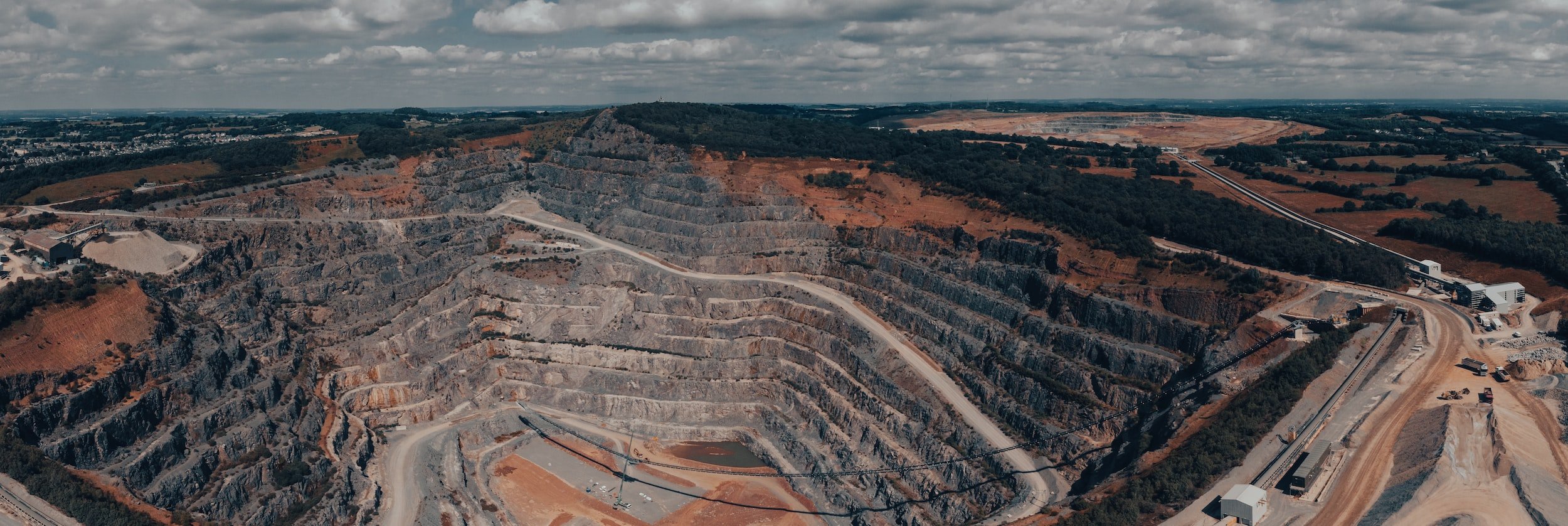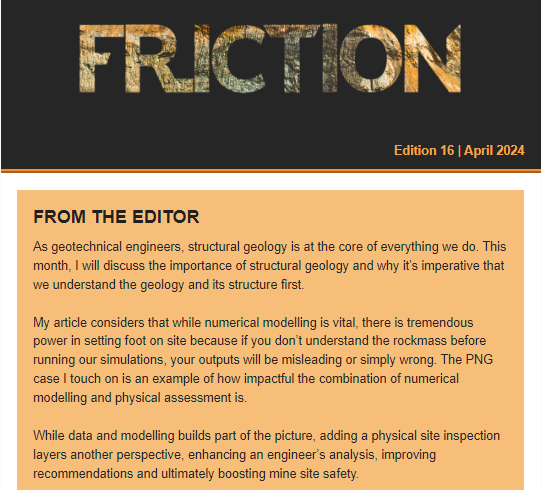
Friction: Edition 20 | August 2024
Welcome to August! This month, we delve into the varying standards of geotechnical education and training around the globe.
Australian geotechnical engineers are fortunate to operate in an advanced industry, with ample access to resources, technology and development opportunities. But not every resource-rich nation is the same. With a shortage of engineers coming through, there is a significant need to address advancement in training geotechnical engineers in resource-rich developing countries, to ensure a thriving industry globally.
Unearthing a global challenge: Training and advancing geotechnical engineers in resource-rich developing countries
When it comes to training and developing geotechnical engineers, the global playing field is anything but level. Natural-resource-rich developing countries face compounding challenges, extending from resources, facilitation of formal programs and funding, to talent attraction and retention, often with complex cultural systems also at play.
Cartledge Mining and Geotechnics Principal Consultant Tim Cartledge explores this globally significant issue, with insights from Senior Lecturer Jannie Maritz from the University of Pretoria, South Africa.
Friction: Edition 19 | July 2024
We are officially past the halfway point of 2024 and so far in Friction we have covered everything from Corporate Governance to Safety in Design to Numerical Modelling and Laboratory Testing. For this edition, we dive into raiseboring and how geotechnical investigation and thorough assessment is essential to reducing uncertainty and risk in the process, but must occur without compromising how findings are delivered.
Deep diligence before the dig: How thorough geotechnical investigation lifts raiseboring safety and efficiency concerns
Raiseboring – creating a vertical shaft into underground mine pits without explosives – is conceptually straightforward. In practice, however, it can be a complex story, with many factors including location ground condition and structure, projected service lifespan and other engineering considerations at play.
In this article, Phillip Quinn, Cartledge Mining and Geotechnics Senior Geotechnical Engineer, explores the process and how thorough geotechnical investigation, in collaboration with all stakeholders, can greatly improve a raiseboring project’s safe completion.
Friction: Edition 18 | June 2024
Good governance encompasses not only the system by which organisations are controlled, but the mechanisms by which organisations and those who comprise them are held to account.
This month we dive deep into corporate governance framework and look at the crucial role the board of governance plays in navigating sustainability, risk management and legislative requirements.
Corporate Governance: Mining geotechnics and the storage of tailings
From the planning and design phases to closure and rehabilitation, corporate governance has significant impacts throughout the entirety of a mine’s life cycle. So, it is important that we, as geotechnical engineers, understand the structures behind corporate governance to best achieve compliance.
In this piece, Wouter Hartman explores how governments and regulators are striding towards a more sustainable and safe future for the mining industry, through the improved regulatory, compliance and risk management processes that underpin how a corporation conducts its business. Wouter also shares his knowledge on common corporate governance structures.
Friction: Edition 17 | May 2024
Safety and mining go hand in hand. With the majority of work being performed in high-pressure environments for long hours at a time and in remote locations, there are a number of factors to consider when thinking about the health, safety and well-being of all on site.
In this month’s edition, we explore the importance of incorporating safety in design and why safety measures must be featured prominently throughout the entirety of a project, from concept to closure.
Safety in Design in Geotechnical Engineering
Design optimisation is frequently front of mind when designing a mining project. However, in an industry with a high potential of risk, it is of the utmost importance that we, as geotechnical engineers, place higher value on incorporating safety measures in the design process to ensure the safety of workers on a mine site.
Scott Lines, Senior Geotechnical Engineer at Red Earth Engineering, discusses how safety must be prioritised in every phase of operations, including from the conceptual to the detailed design phase, and provides key tips on how to incorporate the essential safety measures in design to best prepare for the common pitfalls.
Friction: Edition 16 | April 2024
As geotechnical engineers, structural geology is at the very core of everything we do. This month, I personally dive into the importance of structural geology and why it’s imperative we look at the rocks first.
First things first, just look at the rocks
For geotechnical engineers, it’s easy to go straight for the detail, the data, and pour energy into what’s perceived, and known, to work best. In this article, Cartledge Mining and Geotechnics Director Tim Cartledge explores the simple yet often overlooked process of stepping away from the desk, getting out on site and just looking at the rocks – adding another dimension to the benefits of numerical modelling – to gain the fullest picture of what’s really going on.
Friction: Edition 15 | March 2024
As geotechnical professionals, we are responsible for providing accurate advice about mine design and operations, and laboratory testing is one of the avenues that enables us to do just that.
In this month’s edition, we dig deep into the importance of geotechnical lab testing within the mining, resources and construction industries.
Laboratory Testing of Rock Properties: Challenges and Opportunities
When it comes to geotechnical investigation and design, laboratory testing plays a fundamental role in ensuring the success of any project. However, like any industry, when you take a look under the microscope there are usually more than one challenge that need to be addressed.
In this article, Zhongwei Chen, Associate Professor for the School of Mechanical & Mining Engineering, at The University of Queensland, investigates the challenges such as sample availability and preparation, which hinder laboratory testing and how addressing such challenges can provide long term benefit for Australia’s mineral and resources sector well into the future.
Friction: Edition 14 | February 2024
Welcome to the first edition of 2024. New year, same excellence in geotechnical news and information from across the globe.
This month, we dive deep into data acquisition and data management. From the technological advancements that affect the industry to the rising importance of sufficient data management, this edition provides valuable insight into why data and mining go hand-in-hand.
Garbage in, garbage out. The importance of data acquisition and data management
At its core, geotechnical engineering is nothing without accurate and complete Data Acquisition and Data Management.
In this article, Jed Watts, Client Relationship Manager at Datanest - software that enables the geotechnical industry to improve efficiency and accuracy – looks at the pivotal role data plays in ensuring not only the technical success of a project but also the efficiency and cost-effectiveness of the entire process.
From optional to essential: the changing landscape of quality control in geo data collection
As industry adopted data sharing standards become more complex, the need to understand quality control around geo data collection is as crucial as ever.
In his article, Declan Vanderhor from TabLogs looks at the changing landscape of data and how organisations can leverage their own internal databases to scale for efficiency and effective outcomes.















